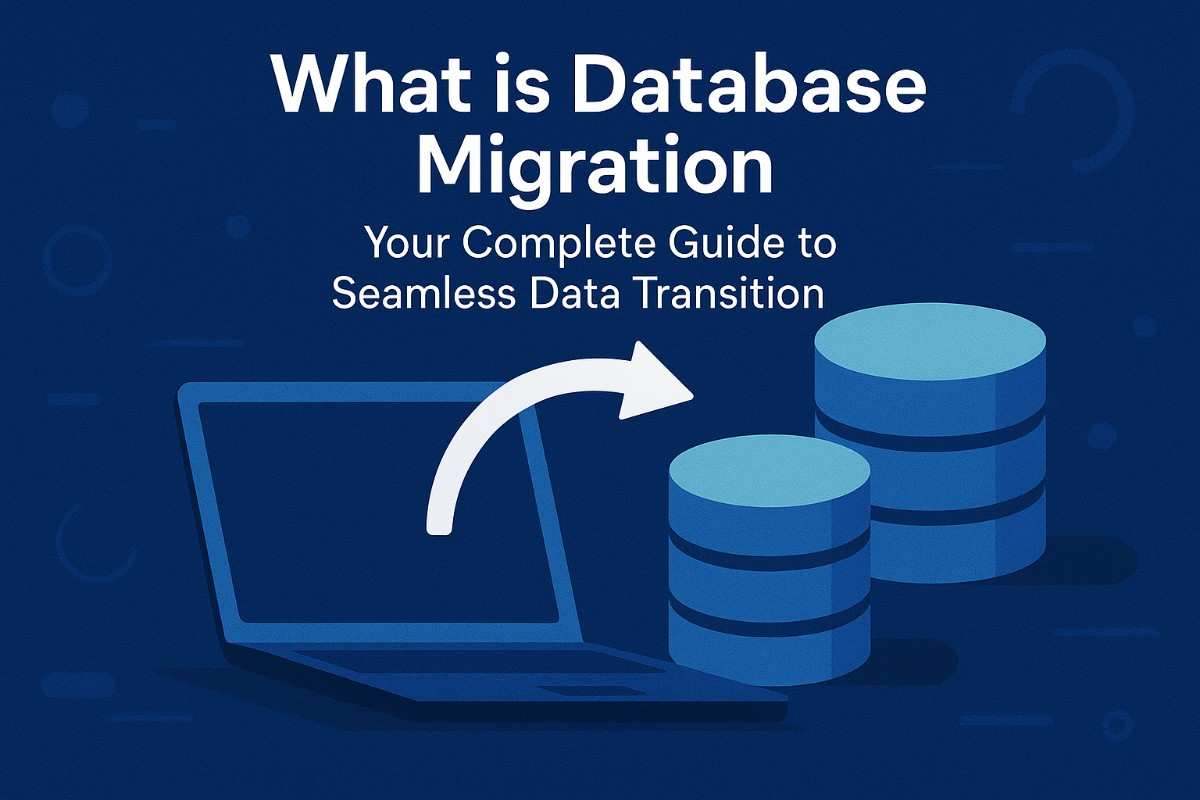Have you ever wondered how companies successfully move their critical data from one system to another without losing information or disrupting business operations? The answer lies in database migration – a crucial process that’s becoming increasingly important as businesses modernize their IT infrastructure.
In today’s rapidly evolving technological landscape, organizations frequently need to upgrade their database systems, move to cloud platforms, or consolidate multiple databases. Understanding what database migration entails and how to execute it properly can mean the difference between a smooth transition and a costly disaster.
Whether you’re an IT professional planning your first migration project or a business leader trying to understand the implications of moving your data, this comprehensive guide will walk you through everything you need to know about database migration.
Understanding Database Migration Fundamentals
Database migration is the process of moving data from one database system to another. Think of it as relocating your entire digital filing cabinet from one location to another – except this filing cabinet contains millions of interconnected documents that must arrive at their destination intact and in perfect order.
At its core, database migration involves transferring data, database schemas, stored procedures, triggers, and other database objects from a source system to a target system. This process isn’t simply about copying and pasting information; it requires careful planning, execution, and validation to ensure data integrity and system functionality.
The need for database migration typically arises from several business drivers. Companies might be upgrading to newer database versions for enhanced performance and security features. Others are moving from expensive proprietary systems to cost-effective open-source alternatives. Increasingly, organizations are migrating their on-premises databases to cloud platforms to benefit from scalability, reduced maintenance overhead, and improved disaster recovery capabilities.
Database migration also plays a crucial role in digital transformation initiatives. As businesses adopt new technologies and modernize their applications, they often need to restructure their data storage to support new requirements and improve operational efficiency.
Types of Database Migration
Homogeneous vs. Heterogeneous Migration
Understanding the different types of database migration helps you choose the right approach for your specific situation.
Homogeneous migration involves moving data between databases of the same type – for example, upgrading from MySQL 5.7 to MySQL 8.0, or moving from one Oracle instance to another. These migrations are generally less complex because the source and target systems use the same database engine, data types, and SQL syntax.
Heterogeneous migration presents greater challenges as it involves moving data between different database systems – such as migrating from Oracle to PostgreSQL, or from SQL Server to MySQL. These migrations require careful mapping of data types, conversion of stored procedures, and adaptation of application code to work with the new database system.
Migration Scenarios
On-premises to cloud migration has become increasingly popular as organizations seek to reduce infrastructure costs and improve scalability. This type of migration involves moving databases from local servers to cloud platforms like AWS, Azure, or Google Cloud Platform.
Legacy system modernization focuses on replacing outdated database systems with modern alternatives. These projects often involve migrating from older systems like mainframe databases or early relational database management systems to contemporary solutions that offer better performance, security, and integration capabilities.
Database consolidation projects aim to reduce complexity and costs by combining multiple databases into fewer, more efficient systems. This approach helps organizations streamline their data management processes and reduce licensing and maintenance costs.
The Database Migration Process
Pre-Migration Planning
Successful database migration starts long before any data moves. The assessment and discovery phase involves thoroughly understanding your current database environment, including data volumes, complexity, dependencies, and performance characteristics.
During this phase, you’ll catalog all database objects, identify custom code and stored procedures, map data relationships, and assess the compatibility between source and target systems. This comprehensive inventory becomes the foundation for your migration plan.
Risk analysis forms a critical component of pre-migration planning. You’ll need to identify potential issues such as data type incompatibilities, performance bottlenecks, application dependencies, and compliance requirements. For each identified risk, develop mitigation strategies and contingency plans.
Migration Execution Phases
The actual migration process typically follows a structured approach involving data extraction, transformation, and loading (ETL).
Data extraction involves reading data from the source database while ensuring consistency and completeness. This phase often requires creating snapshots or implementing change data capture mechanisms to handle ongoing transactions during the migration process.
Data transformation addresses differences between source and target systems. This might involve converting data types, restructuring schemas, adapting stored procedures, or applying business rules to ensure data quality in the target environment.
Loading and validation procedures ensure that transformed data arrives correctly in the target system. This phase includes verifying data integrity, checking referential constraints, and validating that all database objects function as expected.
Common Database Migration Strategies
Choosing the right migration strategy depends on your specific requirements, constraints, and risk tolerance.
Big Bang migration involves completing the entire migration during a planned downtime window. While this approach minimizes complexity and ensures a clean cutover, it requires extended downtime and carries higher risk if issues arise during the migration process.
Phased migration methodology breaks the migration into smaller, manageable chunks. You might migrate different database schemas, tables, or application modules in separate phases. This approach reduces risk and allows for learning and adjustment between phases, but it requires more complex coordination and potentially longer overall timelines.
Parallel run strategy involves running both old and new systems simultaneously for a period. This approach provides the ultimate safety net, allowing you to compare results and switch back if needed. However, it requires additional resources and careful synchronization between systems.
Tools and Technologies
Enterprise Migration Tools
AWS Database Migration Service offers a comprehensive platform for migrating databases to AWS cloud services. It supports both homogeneous and heterogeneous migrations and provides continuous data replication capabilities to minimize downtime.
Azure Database Migration Service provides similar capabilities for organizations moving to Microsoft’s cloud platform. It includes assessment tools to help plan migrations and supports various source and target database combinations.
Google Cloud Database Migration offers specialized tools for migrating to Google Cloud Platform, with particular strength in migrating from on-premises systems to fully managed cloud databases.
Open Source Solutions
Many organizations prefer open-source migration tools for their flexibility and cost-effectiveness. Popular frameworks include Flyway for version control and migration scripts, Liquibase for database change management, and various ETL tools like Talend or Apache NiFi.
Custom migration scripts remain popular for complex or highly specialized migrations. While they require more development effort, they provide maximum control over the migration process and can be tailored to specific business requirements.
Challenges and Best Practices
Database migration projects face numerous challenges that require careful attention and planning.
Data integrity and consistency issues top the list of concerns. Ensuring that all data transfers correctly and maintaining referential integrity across related tables requires rigorous testing and validation procedures. Implement checksums, row counts, and data sampling techniques to verify migration accuracy.
Downtime minimization techniques become crucial for business-critical systems. Consider implementing change data capture to synchronize ongoing transactions, use read replicas to serve queries during migration, or implement blue-green deployment strategies to enable rapid cutover.
Performance optimization strategies ensure that the migrated system meets or exceeds the performance of the original system. This involves proper indexing, query optimization, and potentially restructuring data to take advantage of new database capabilities.
Post-Migration Considerations
The work doesn’t end when data arrives in the target system. Testing and validation procedures must verify that all applications function correctly with the new database, performance meets expectations, and data integrity remains intact.
Performance monitoring and optimization become ongoing activities. Monitor key metrics, identify bottlenecks, and fine-tune the system to achieve optimal performance. This might involve adjusting configuration parameters, optimizing queries, or restructuring indexes.
Rollback planning and disaster recovery provide crucial safety nets. Maintain the ability to quickly revert to the original system if critical issues arise, and ensure that backup and recovery procedures work effectively with the new environment.
Conclusion
Database migration represents a critical capability for modern organizations seeking to modernize their IT infrastructure, reduce costs, and improve operational efficiency. While the process involves significant complexity and risk, proper planning, tool selection, and execution can lead to successful outcomes that deliver substantial business value.
The key to successful database migration lies in thorough preparation, realistic timeline planning, and comprehensive testing. By understanding the different types of migrations, choosing appropriate strategies and tools, and following established best practices, organizations can navigate the complexities of database migration while minimizing risks and disruptions.
Remember that database migration is not just a technical project – it’s a business transformation that requires coordination between IT teams, application developers, and business stakeholders. With careful planning and execution, database migration can serve as a catalyst for improved performance, reduced costs, and enhanced capabilities that support your organization’s long-term success.
FAQs
Q: How long does a typical database migration take? A: Migration timelines vary significantly based on data volume, complexity, and chosen strategy. Simple migrations might complete in hours or days, while complex enterprise migrations can take weeks or months. Factors include data size, number of applications, testing requirements, and acceptable downtime windows.
Q: What’s the biggest risk in database migration projects? A: Data loss or corruption represents the most significant risk, followed by extended downtime and application compatibility issues. Proper backup procedures, thorough testing, and rollback plans are essential for mitigating these risks. Many organizations perform multiple test migrations before executing the final cutover.
Q: Can we migrate databases without any downtime? A: Near-zero downtime migrations are possible using techniques like change data capture, read replicas, and blue-green deployments. However, some minimal downtime is usually required for final cutover and DNS changes. The achievable downtime depends on your specific environment and requirements.
Q: How much does database migration typically cost? A: Costs vary widely based on data volume, complexity, and chosen approach. Factors include software licensing, cloud services, professional services, and internal resource allocation. Simple migrations might cost thousands of dollars, while complex enterprise projects can reach hundreds of thousands or more.
Q: Should we migrate everything at once or in phases? A: The choice depends on your risk tolerance, downtime constraints, and system complexity. Big bang migrations are faster but riskier, while phased approaches reduce risk but increase complexity and duration. Consider your specific requirements, dependencies, and organizational capabilities when making this decision.




